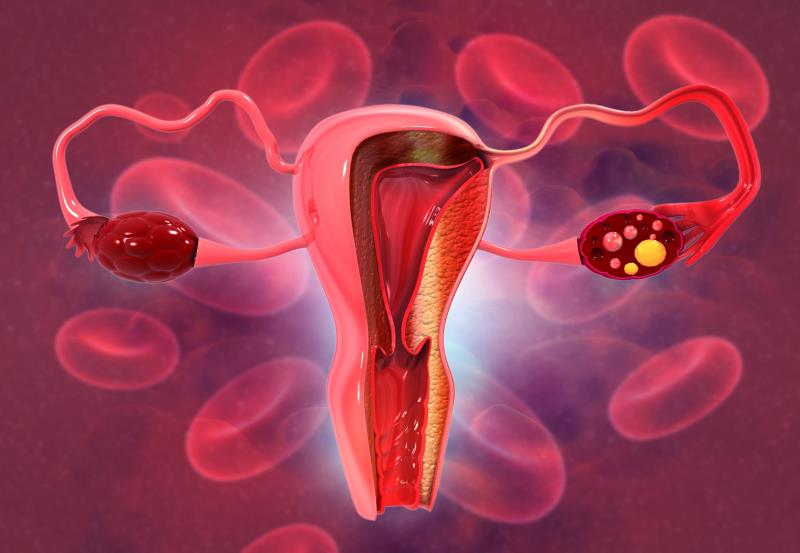Raludotatug deruxtecan shows efficacy signal in platinum-sensitive ovarian cancer





The cadherin 6 (CDH6)-directed antibody–drug conjugate raludotatug deruxtecan elicits response in heavily pretreated patients with platinum-sensitive ovarian cancer while having a manageable safety profile, according to a subgroup analysis of an ongoing first-in-human phase I trial.
Over a median follow-up of 8.3 months, 13 out of 18 patients responded to treatment, all of whom experienced a partial response. The confirmed objective response rate (ORR) was 72.2 percent (95 percent confidence interval [CI] 46.5–90.3), reported presenting study author Dr Kathleen Moore of Stephenson Cancer Center, University of Oklahoma, Oklahoma City, Oklahoma, US. [ESMO GYN 2025, abstract 77MO]
It took a median of 1.4 months for patients to show response to raludotatug deruxtecan, and this response lasted a median of 5.7 months.
Disease control rate was 88.9 percent (95 percent CI, 65.3–98.6), and clinical benefit rate was 77.8 percent (95 percent CI, 65.3–98.6). The median progression-free survival (PFS) was 8.1 months.
When looking at the subset of 12 patients who progressed on a PARP inhibitor, Moore noted that the confirmed ORR was still quite high at 58.3 percent (95 percent CI, 27.7–84.8). Median time to response was 1.4 months, and the median duration was 5.1 months. Disease control and clinical benefit rates were 83.3 percent and 66.7 percent, respectively. The median PFS was 7.1 months.
In terms of safety, treatment-emergent adverse events (TEAEs) occurred in all 18 patients, including grade ≥3 events in 14 (77.8 percent). The most common any-cause TEAEs were nausea (50 percent), anaemia (38.9 percent [grade ≥3 22.2 percent]), and fatigue (38.9 percent [grade ≥3 5.6 percent]).
TEAEs related to treatment were documented in 16 patients (88.9 percent), none of which were fatal. Serious AEs were reported in five (27.8 percent), and none of these were related to treatment.
Only two patients (11.1 percent) discontinued treatment due to toxicity. Dose interruption and reduction occurred in seven (38.9 percent) and four (22.2 percent) patients, respectively.
“The safety profile of raludotatug deruxtecan was manageable and consistent with previous reports in patients with advanced ovarian cancer,” Moore said. [ESMO 2023, abstract 745MO; Moore KN, et al, Society of Gynecologic Oncology 2024]
“These encouraging results of treatment with raludotatug deruxtecan 4.8 to 6.4 mg/kg in patients with platinum-sensitive overall cancer, many of whom had disease progression following PARP inhibitor treatment, support further investigation of the drug in this patient population,” she added.
Raludotatug deruxtecan is an antibody drug conjugate comprising a humanized anti-CDH6 IgG1 monoclonal antibody covalently linked to a TOPO I inhibitor payload. Moore noted that in ovarian cancer, CDH6 is expressed in 65 percent to 85 percent of patients.
However, when the importance of CDH6 as a biomarker was assessed, she pointed out that there was no strong correlation between CDH6 expression and clinical benefit with raludotatug deruxtexan, just as in prior presentations.
The phase I trial was conducted in two parts and included 18 patients (median age 65 years) who had advanced or metastatic ovarian cancer not amenable to standard treatment, had an ECOG performance score of 0 or 1, had been exposed to a taxane and platinum-based chemotherapy, and had not received prior CDH6-targeting agents or antibody drug conjugates linked to a TOPO I inhibitor. These patients were not selected based on tumour CDH6 expression.
The first part consisted of the dose-escalation phase, wherein patients were treated with raludotatug deruxtecan at doses of 1.6 (n=1), 3.2 (n=4), 4.8 (n=7), 6.4 (n=4), 8.0 (n=8), or 9.6 mg/kg (n=3). Moore said the 8-mg/kg dose was discontinued due to an unfavourable toxicity–efficacy ratio. The second part was the dose-expansion phase, wherein patients were treated with raludotatug deruxtecan at 4.8 (n=40), 5.6 (n=42), and 6.4 mg/kg (n=40). In both phases, treatment was administered intravenously every 3 weeks.
Of the patients, 14 were from the US (77.8 percent) and four were from Japan (22.2 percent). Most patients had an ECOG performance score of 1 (77.8 percent) and had received prior bevacizumab treatment (77.8 percent) and PARP inhibitor treatment (83.3 percent). The median number of prior systemic regimens was 4, and the median tumour CDH6 membrane positivity was 67.5 percent.